Staten Island WBE Grows Despite Geographic Challenges

Ford Wadsworth, Staten Island (photo: National Park Service)
The following entry is part of The Small Business Corner, a collaboration between Gotham Gazette and GoBizNYC:
GoBizNYC recently spoke with Ryan Walsh, President of Walsh Electrical Contracting, a long-established family-owned business based on Staten Island that continues to find new opportunities to grow and evolve thanks to the city's large and diverse market potential. The City's minority & women-owned business enterprise (M/WBE) program was key to the firm's most recent expansion. Walsh participated in the record $690 million in city contracts awarded to M/WBEs by the de Blasio Administration last month, a figure that has much room for growth, according to recent analysis of the program by Comptroller Stringer. The company's experience shows that, while New York City businesses face significant challenges, they also have great opportunities, especially when government is committed to supporting its business community.
Tell us about your business.
Walsh Electric was founded in 1979 by my parents, Kevin and Linda Walsh. They joined Local Union #3 of the IBEW and began serving the residential and commercial markets on Staten Island. I grew up in the business, working on weekends and during school breaks. After college, I owned and operated my own businesses. In 2011, my father's health began to deteriorate, and I returned to work at Walsh Electric so that he could have open heart surgery. He passed away unexpectedly later that year.
My mother and I decided to continue to operate the business. Now that my mother was majority owner, we felt the next logical step was to become part of the city and state certified WBE programs. In 2012, our WBE application was approved. Since my father's passing, we have grown 300% to over $20 million in sales and today we employ over 100 people in the field and the office. We are licensed by the City of New York and work exclusively in the five boroughs.
How has being WBE-certified helped your business?
Being a WBE enabled us to expand into the public sector. We have been involved in projects for Hurricane Sandy recovery as well as the Department of Environmental Protection (DEP), the Metropolitan Transit Authority (MTA), and the School Construction Authority (SCA). Many agencies require that prime contractors hire M/WBE firms as part of their contract agreements and Walsh Electric can fill that void. Today, about 25% of our business is made up of WBE work. That equates to roughly $5 million per year – revenue we wouldn't have without the WBE certification. This has allowed us to hire an additional 25 employees.
What are the opportunities of operating your business in NYC?
Operating an electrical business in NYC has many opportunities. This is the country's biggest market and there is a lot of development activity, whether it's new construction, renovation, or maintenance. All of this requires electrical contractors.
NYC is the premier place to live and work, so people will always be here, always want to be here, and will always demand the newest, best, and most exciting experience. In addition, the city's extensive waterfront and as well as inland rezoning have allowed for development beyond anyone's imagination. Plus, as technology advances, there will be greater demand for LEDs, electric cars, and wind and solar power. This will, in turn, only increase demand for electrical contractors.
What are the challenges of operating a business in NYC?
Logistics are tough. Being based on Staten Island while performing most of our work in other boroughs involves a big expense in gas, tolls, and time. Another challenge is that there is a lot of competition and when there are periodic slowdowns in the economy and construction activity, it hits us. High city and state taxes are also a burden.
Construction in the city is complex and involves a lot of permits, penalties, regulations, and inspections that drive up costs. For example, the Department of Buildings has been frequenting sites more often, leading to more fines and delays. There are a huge number of government agencies to deal with and there are lots of bureaucratic obstacles, such as getting approvals for design changes from the MTA, that lead to long project delays.
In what ways can local government better support your business?
Staten Island is going to benefit from the development of Empire Outlets and the New York Wheel, with the support of state and local government. But the City could do more to promote and support business and development activity here in Staten Island. New neighborhoods, such as Williamsburg and DUMBO in Brooklyn, are flourishing because of high density, vertical development, and good public transportation. This does not exist here. Traffic is a major issue. Expensive tolls and long commute times are a deterrent to people living and working here. As a result, Staten Island and its businesses have not gotten the same benefits of population and job growth as the other boroughs.
Staten Island's local officials are doing a great job for us. The challenge is getting the rest of the City to recognize us. Although we are one of the five boroughs, we are often forgotten.
***
Victor Wong is the Director of Business Outreach & GoBizNYC at the Partnership for New York City
To make or discuss a submission for The Small Business Corner:
Reach GoBizNYC Director Victor Wong at This email address is being protected from spambots. You need JavaScript enabled to view it.
Reach Gotham Gazette Executive Editor Ben Max at This email address is being protected from spambots. You need JavaScript enabled to view it.
The Small Business Corner is a bi-weekly column featuring the opinions and perspectives of small business owners and advocates from the GoBizNYC network on the range of issues that concern the city's small businesses.
To all New York City small business owners and advocates: we hope this new platform, The Small Business Corner, will better enable you to engage in the local policy conversation and we look to you to support us in this endeavor by sharing your thoughts, experiences, and voices. To learn more about how you can be a part of GoBizNYC and participate in this effort, visit GoBizNYC.org.
Back-Stage Blood-Sport: Robert Carroll's The Believers
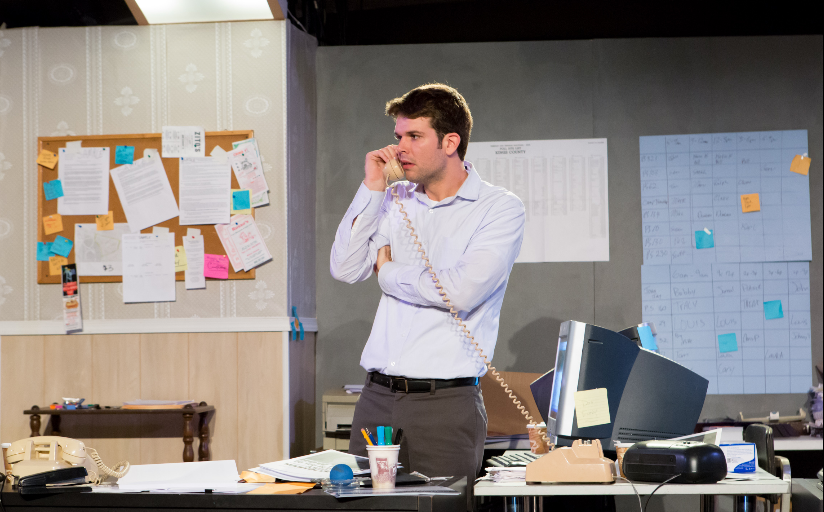
The campaign manager (both photos: Michael Abrams)
The hoary axiom that "politics ain't beanbag" is most often used these days when a candidate hits an opponent's character hard. But beanbag refers not just to a soft object that won't hurt; it's also a game with agreed-upon rules. And whether to play by, bend, or break the rules makes for good drama, whether on the campaign trail or stage. Working in the tradition of Gore Vidal's 1960 classic The Best Man, playwright Robert Carroll applies these questions to the rough-and-tumble world of New York City politics.
Set in Bill de Blasio's former city council district in and around Park Slope, Carroll's The Believers explores the world where most decisions get made: campaign headquarters. It's here where lead staffers hash out battle plans, often without the candidate's direct input. Carroll's play uniquely captures the adrenaline-rush felt inside campaign HQ as the day of reckoning approaches. And the Storm Theatre serves up a strong, fast-paced production, one that anyone interested in politics will likely appreciate.
Carroll, nearing 28, has grown up in city politics (and is currently the president of Central Brooklyn Independent Democrats). I asked to him to explain some background of the piece.
Your play is addressing a key ethical dilemma that arises in campaigns regarding 'how low will one side go?' in order to win. But most campaign decisions are really based on cold practical calculations. So are the "believers" here the starry-eyed idealists?
Practicality and idealism are often times thought of at opposite ends of the intellectual spectrum, but I think the play actually shows how idealism can lead to extremism and how those convictions can make people do terrible things under the guise of practicality. The main character betrays his idealism at the beginning of the play because he is so sure of the righteousness of his own beliefs. The conflict of the play revolves around whether the campaign will engage in defaming its leading opponent with a salacious piece of campaign literature on the morning of Election Day in hopes of suppressing Hasidic turnout in Borough Park. The main character—Chris, the campaign manager—justifies to himself that his decision to do the underhanded is morally valid because he believes the other side is so bad that no matter what he does the other side would be worse if they were to win. Of course, that underhanded and possibly practical choice made by Chris causes his downfall.
Your bio in the program says that you've worked on "countless campaigns" but the other night I sat next to Josh Skaller (currently a district leader in Brooklyn). He said that the storyline is an amalgam of a few specific races. Can you explain which ones?
I would say the play is part amalgamation of multiple campaigns, some of which I rely on more than others for reference points. However, many parts of the play are completely made up. I use my own experience to give authenticity, as well as build on, the larger metaphor about what people are willing to do for their beliefs. A political campaign is part marketing and part debate. Josh Skaller's 2009 city council campaign (against Brad Lander) was used as a foundation for the composites of some the characters and action in the play. I used some of the individuals who worked on that campaign because I personally respect them intellectually and fortuitously their sensibilities and conflict happen to be somewhat divergent from one another, which helps create dramatic conflict.
One of the characters was drawn from a 2010 congressional campaign I consulted on. And I also learned from my father, Jack Carroll, and his campaign work as both a candidate and an election lawyer. The play takes place in a very specific time, which I would rather not divulge since it is not readily apparent and is key to the conflict of the play. But I think it is important to note that I have had many politically astute people come see the show and many have thought certain references were in reference to different people or campaigns. I think this shows the universality of the themes and actions.
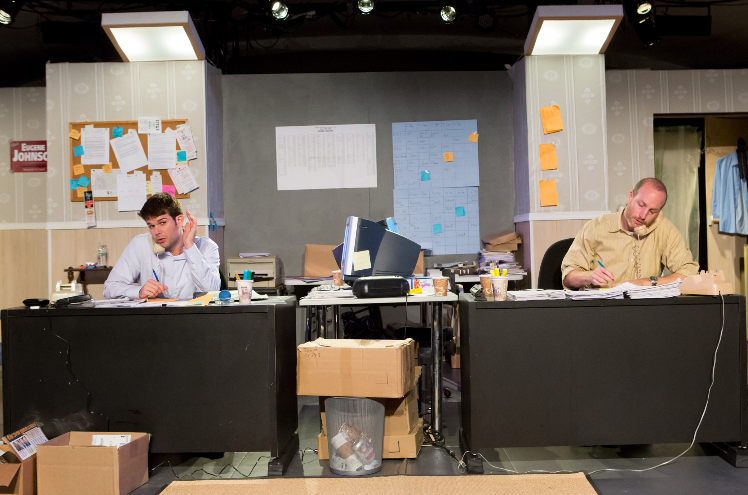
In the play, Chris (played convincingly by Taylor Anthony Miller) wrestles with the fact that his dad is a highly principled person. Are there any lessons he conveyed to you about the importance of staying clean in a dirty game?
I think the central question of the play and the central reason I am interested in politics is answering the question of "how" decisions are made, or the "process." I think if you are going to be involved in politics you should ask yourself 'how do we get where we want to go?' and 'how do we have a more fair system?' The play asks whether process/how we get somewhere is more important than holding the same beliefs as someone. So yes, my father instilled in me and my brothers a sense of fair play and honesty, and that process is very important. And that's what Chris is wrestling with.
As de Blasio's campaign illustrated, so much of politics is about stagecraft--e.g. the LICH arrest, Dante's hair, etc. But your play is about what goes on backstage. What made you decide to give the actual candidate such a minor role?
I wanted to allow the audience to imagine what the candidate was like, in order to create in their mind why these characters would do so much for this mysterious person. Furthermore, I didn't want the themes of the play to become muddled by making it about the personality of the candidates. You mentioned the de Blasio campaign's Dante ad as an example of political stagecraft, and while I agree, that ad also focused on Dante, not the candidate. I think lots of campaign theatrics do not revolve around the candidate but the message or themes they convey. I think often times people project their own feelings or hopes onto a candidate in the belief that it will fulfill something they desire.
***
The Storm Theatre's production of Robert Carroll's The Believers (directed by Stephen Logan Day) runs through November 1 at the Theatre of the Church of Notre Dame in Morningside Heights.
***
Theodore Hamm is chair of journalism and new media studies at St. Joseph's College in Clinton Hill, Brooklyn.
@HammerDaily
De Blasio's New Progressive Criminal Justice Initiatives Overshadowed by Prospect of More Police
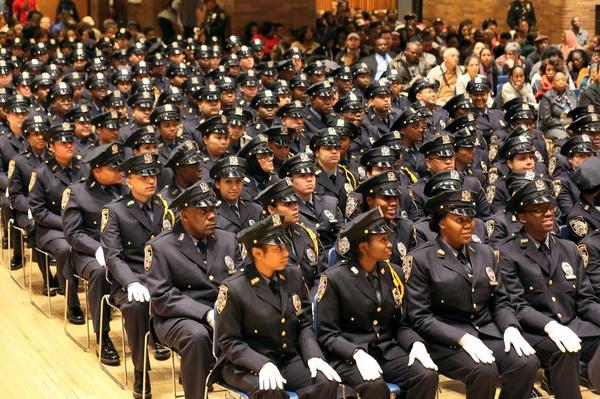
New school safety agents (photo: @CommissBratton)
In the last week the de Blasio administration has announced three new initiatives designed to reduce some of the negative consequences of over-relying on criminal justice solutions to solve community problems. If his administration is serious about moving in this new direction, they need to come out against hiring additional police in next year's budget.
Last week it was announced that New York was planning to adopt aspects of Seattle's Law Enforcement Assisted Diversion (LEAD) program, designed to divert low level offenders from the criminal justice system and into treatment and training programs. Seattle's program relies on officers to refer those they come into frequent contact with in relationship to drugs and prostitution. These are typically repeat offenders who regularly cycle in and out of jails, emergency rooms, and courts at great expense to the city and with only limited and temporary public benefit. Unfortunately, the new plan as conceptualized here is limited to non-arrestable violation offenses, undermining a key source of savings and possibly subjecting people to additional criminal justice involvement over minor offenses.
Hopefully this is just the warm up to a more comprehensive effort to deal directly with the myriad of social problems facing this difficult population.
Next, the mayor announced that he was ordering a major overhaul of school disciplinary procedures. This is great news for anyone who has been following the failed national trend of criminalizing young people through a growing number of zero tolerance policies. Since the NYPD took over school security, the number of young people arrested, cited, and suspended has increased dramatically. While this policy change does not directly affect NYPD school safety officers, it sends a message to school officials that they need to take greater responsibility for managing school safety without relying on ever more punitive measures. A recent report by a task force put together by former New York State top Judge, Judith Kaye, showed that well-trained principals in even the most difficult to manage schools have been able to dramatically reduce suspensions and arrests without undermining student safety.
Finally, the Department of Corrections announced a new policy this week that would end the use of solitary confinement for juveniles on Rikers Island. During a recent visit I made to Rikers I saw that almost 20% of juveniles were held in solitary conditions and in the process denied access to educational programs. A growing body of research has shown that solitary conditions are especially traumatic for juveniles and may serve to make them more violent and socially withdrawn upon release. This is a major positive development, leading some, like Council Member Elizabeth Crowley, to call for removing juveniles from Rikers altogether given its entrenched culture of violence.
All of this stands in stark contrast to last month's announcement by Police Commissioner Bill Bratton that in next year's budget cycle he intends to ask for at least 1,000 additional police officers. This would be a major step in the wrong direction and if included in the mayor's budget, would substantially undermine his claims of progressive criminal justice reform.
While the NYPD has an important part to play in creating social stability, its role has been dramatically over-extended in the last two decades. With the expansion of the War on Drugs and the adoption of Broken Windows-based policing, the NYPD has taken on a wide variety of tasks that it is not particularly well-suited for.
Despite decades of intensive anti-drug policing, which has given hundreds of thousands of mostly brown and black people criminal records, the NYPD has few victories to point to. While it's true that open air drug markets have been reduced through intensive criminalization, drugs are just as easily obtained as ever. Any high school student in New York can easily obtain any drug they choose. Overdose rates and other health problems associated with drug use have shown no signs of improvement either. It's time to take police out of the drug business and turn it over to public health officials. Decriminalization of drugs in parts of Europe has been a huge success leading to lower crime and better health outcomes. The full legalization of marijuana as in Colorado and Washington would be a start.
Despite the claims of its supporters, there is little to no academic evidence that Broken Windows policing has made us safer or is worth the high cost of criminalizing hundreds of thousands of mostly non-white New Yorkers every year. Yes, it can be used to drive out a homeless encampment or get rid of squeegee men, but it is not the reason for a multi-decade international crime drop that has occurred in hundreds of cities that never practiced it. It's time that we stopped criminalizing poverty and disorder and found more effective and less costly ways of improving the quality of life of all New Yorkers. Major investments in affordable housing, adequate mental health services, and meaningful employment opportunities are the humane, just, and cost effective ways of moving forward.
Some will dismiss this advice as a soft-hearted liberal appeal for more social spending. The evidence, however, is clear that we cannot police or incarcerate our way out of the social problems facing the city. And, even if we could, we can no longer afford the implications for racial and economic inequality that undergird such an approach. This administration understands this reality and needs to quit trying to have it both ways. It's time to double down on alternatives to criminalization.
***
Alex S. Vitale is associate professor of sociology at Brooklyn College and author of City of Disorder: How the Quality of Life Campaign Transformed New York Politics. He is senior policy adviser to the Police Reform Organizing Project and serves on the New York State Advisory Committee to the US Civil Rights Commission. You can follow him on Twitter at @avitale.
Bill Bratton, Robert Peel, and Today's Police
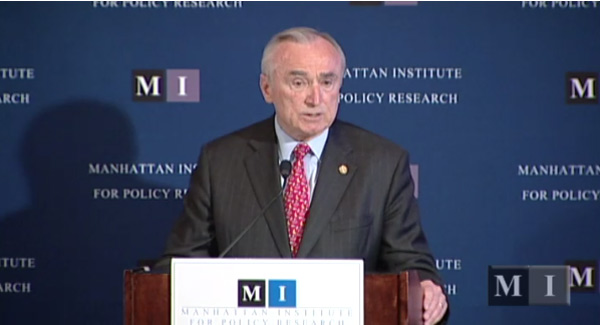
NYPD Commissioner Bill Bratton speaking at a Manhattan Institute event
New York City Police Commissioner William Bratton often refers in public to his hero, Sir Robert Peel, a 19th century Englishman who espoused a community-oriented policing philosophy. The nine Peelian principles include such views as:
- The ability of the police to perform their duties is dependent upon public approval of police actions.
- Police must secure the willing cooperation of the public in voluntary observation of the law to be able to secure and maintain the respect of the public.
- Police seek and preserve public favor...by constantly demonstrating absolute impartial service to the law.
Peel's principles make no reference to a law enforcement approach resembling the "broken windows" theory promoted by Mr. Bratton, that a focus on low-level infractions like jaywalking, spitting on the sidewalk, or holding an open alcohol container will lead to a reduction in serious violent offenses. Nor does Mr. Peel mention the kind of numbers-driven policing that characterizes so much of the activity of NYPD officers.
I wonder what Mr. Peel and, in fact, Mr. Bratton would think about my recent conversation with a current New York City cop. While making a deposit at a bank near my office, I overheard the police officer posted there explaining to two tellers what the cops responsible for Eric Garner's death did wrong.
Interested in hearing more of his specific thoughts, I asked what he would have done differently. "First," he said, "you take your time and talk, your initial steps to persuade the guy to think better of sticking with his first impulse which is to object to the arrest. 'We can do this the easy way,' you say, 'or we can do it your way.' Then you explain that you have backup and that 'it won't be a fair fight, it's never a fair fight.'"
In addition, the officer explained, "you always take it very seriously when the person says something like 'I can't breathe', even if you think he's faking it. It's too dangerous not to."
I commented that it was especially troubling that the infraction involved, selling loose cigarettes, was so minor. "You know," the officer responded, "I'll be honest with you" -- a phrase that he repeated twice during our conversation -- "there are quotas. Each precinct has a conditions squad and they're under pressure to make their numbers. Arrests or tickets for quality of life things."
At this point in our back and forth, he was talking freely. Some of his other revealing thoughts and comments included:
-Quotas for evaluating police performance are 'unwritten', but each precinct has them and they are different for each neighborhood. So the numbers that the 'higher ups' expect you to meet are higher say, in Harlem, where he used to work than in Midtown Manhattan where the bank is located.
-"It is easier to arrest a black or brown kid" in Harlem. He stated that he would not under any circumstances arrest an Orthodox Jewish person from Brooklyn, where he also used to work. "They will make a cop's life miserable," he said, because they're well organized and can draw on their political connections.
-Once, due to an urgent family situation, he asked for an unplanned day off. "Like to help you out," his supervisor said, "but I have to check on your activity." 'Activity' is a code word for arrests, summonses, and stops; in other words, the officer would qualify for the day off only if he had met his quota.
-When I asked whether the quota system within the Department credited officers for positive activities like breaking up fights, settling disputes, or directing people in need of services like the homeless or mentally ill to places that offer appropriate services, he said no, only for sanctions like 'collars' or tickets.
-He said that sometimes you can see the trail for "quality of life" directives, pressure from headquarters to borough commanders, precinct captains to lieutenants, and sergeants to cops on the street.
-"I became a police officer because I wanted to help people," he said, "but the job doesn't support it." He shook his head. "I want to do the right thing but I'll get hanged for it."
I do not know exactly what "I'll get hanged for it" means here. I am fairly certain, though, that the officer referred to an on the ground culture within today's NYPD that is antagonistic to activities aimed at helping or befriending members of the community. I am also fairly certain that Mr. Peel and, for that matter, Mr. Bratton would not approve of such a police department. The key challenge for Mr. Bratton and for his boss, Mayor Bill de Blasio, and for all New Yorkers is how to create an NYPD that actually adheres to the "Peelian" principles and that fosters an institutional environment that rewards rather than intimidates officers who seek a constructive relationship with the people whom they are sworn to serve and protect.
***
Robert Gangi is the director of the Police Reform Organizing Project (PROP). Find PROP online at its website and on Facebook and Twitter.
Jury Still Out On De Blasio Era Protest
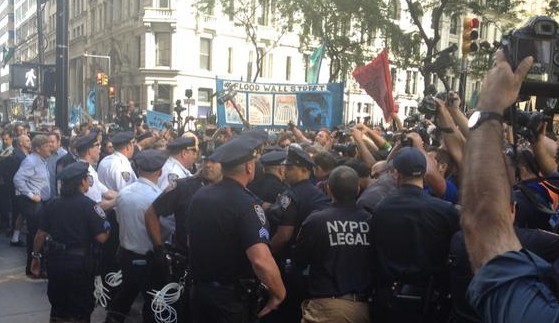
Protestors and NYPD during 'Flood Wall Street' (photo: Azi Paybarah)
The de Blasio administration's handling of the People's Climate March and Flood Wall Street protests has been widely praised by many leading critics of the NYPD.
On Sunday, NYCLU head Donna Lieberman tweeted that the non-confrontational approach taken by Bratton's forces was "#change we can believe in." And writing in Gotham Gazette Tuesday, Brooklyn College professor Alex Vitale suggests that the improved relations between the NYPD and protesters at both Sunday and Monday's events meant that "the First Amendment scored a major victory this week."
But in the spirit of that same amendment, I shall dissent.
Consider the intended locations of both events. Organizers of the People's Climate March sought to make their statement in Times Square, not on the streets surrounding it. And as the name alone indicates, "Flood Wall Street" was neither aimed at lower Broadway, nor the entire financial district.
Forcefully manned NYPD barricades ensured that no demonstrators would gain access to either iconic location during this week's protests.
While some may be tempted to cue up a certain Rolling Stones song, others may wonder about the precedents now set. The next time protest organizers seek access to Times Square, city officials can point to the ill-defined Climate March route as an established alternative.
Vitale suggests that the NYPD may seek for it to be an "apolitical" place, but Times Square does remain public space. At the height of the Occupy Wall Street movement in October of 2011, police allowed a march route from Washington Square to the edge of Times Square, knowing that activists would seek confrontation there.
While it was indeed surprising that Monday's Occupy-style event led to the shutdown of lower Broadway, most observers paid little attention to the fact that Wall Street itself was barricaded throughout the day. If the NYPD allowed a lunch-hour sit-in on Wall Street, that likely would have been less disruptive to business as usual in the area than letting activists control a major artery throughout the entire afternoon.
Both protests thus illustrated the NYPD's growing insistence on insulating the city's most "sacred" spaces from political demonstrations. Is this really a victory for the 1st amendment?
It's also a mistake to see these two events as clearly establishing a definite pattern. After all, as veteran Occupy organizer Stefan Fink told Al Jazeera, they occurred precisely as the "eyes of the world" were on New York City.
Mayor de Blasio was one of the many leading political figures who took part in the Climate March, and he was also slated to address the U.N. climate summit the following day. A hostile approach to a climate change demonstration was clearly not in his best interest.
The mayor's noble proclamations about the 1st amendment also need to be read against the backdrop of his own arrest in the effort to save Long Island College Hospital last year. Many now see that as simply a campaign stunt, but it also makes it hard for the mayor to object to direct action.
Finally, given his lack of leadership on other ongoing policing controversies, a gentler approach to protest also may benefit the mayor politically, since it may calm activists' ire.
Thus, while this week's events indeed suggest a "change" in the climate of protest, it's wiser to reserve judgment until the next large demonstrations take shape—on whatever street they may arise.
***
Theodore Hamm (@HammerDaily) is chair of journalism and new media studies at St. Joseph's College in Clinton Hill, Brooklyn.
NYPD Adopts Less Confrontational Posture at Climate Protests
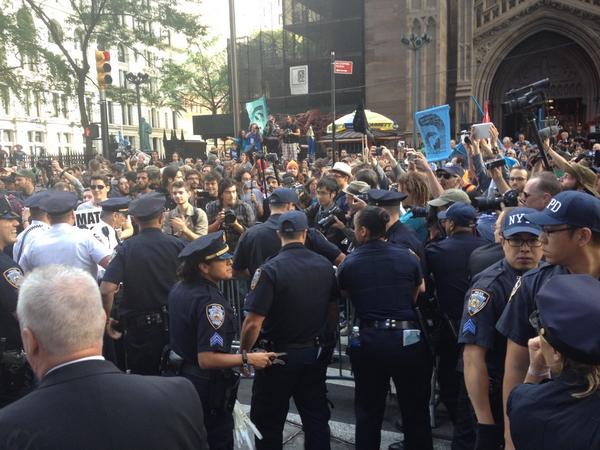
A scene from Monday's Flood Wall Street protest (photo: Azi Paybarah)
For over a decade the NYCLU and others have criticized the NYPD for the way it handles demonstrations. The NYPD's practices have been out of step with international human rights standards and widely accepted best practices. In too many cases the department has relied on a strategy of micro-management backed up by excessive force and in the worst cases has preemptively disrupted protests before they even start, resulting in a cost of tens of millions in legal settlements and unnecessary overtime. The policing of Sunday's People's Climate March and Monday's Flood Wall Street action showed encouraging signs of a break in that approach as police took a less restrictive and more flexible and tolerant posture, reducing the use of barricades and allowing protestors to peacefully occupy lower Broadway for much of Monday.
In 2003, I coauthored a report with the NYCLU following the NYPD's botched handling of the 2003 anti-Iraq War demonstration on Manhattan's East Side. Hundreds of thousands of peaceful protestors were denied the right to protest because of denials of permits, restrictions on access to the demonstration area, and an oppressive overuse of metal barricades to pen in demonstrators.
During the Republican National Convention in 2004, the NYPD relaxed some of its worst practices in terms of access and penning following federal litigation, but continued to needlessly over-police most demonstrations. Another report I co-authored with the NYCLU documented that in a number of instances the NYPD relied on preemptive tactics, including the surveillance of demonstrators, alarmist statements about protestors made to the media, and the outright unlawful arrest of almost 2,000 people before they had even begun demonstrating, much less broken the law.
During the Occupy protests in 2011, the NYPD frequently employed excessive force against demonstrators. People who marched in the street were immediately subjected to pepper spray, punches, mass arrest, and even being dragged by the hair. Even those on the sidewalk or public plazas were subjected to constant harassment and arrest for infractions like using chalk on the sidewalk or speaking into a megaphone.
In several papers I have outlined how these tactics represent a shift away from the widely practiced "negotiated management" style of policing that is flexible and tolerant in an effort to avoid escalations of conflict and violence to the twin strategies of Command and Control and the Miami Model. The former, based in large part on the Broken Windows theory and developed early in the Giuliani administration, attempts to control demonstrators through massive police deployments, extensive use of metal barricades to control people's access to demonstrations and their movement within them, tight limits on the issuing of permits--often based on political calculations, and a zero tolerance outlook towards even minor violations of permits or the law.
The Miami Model is even more restrictive. For demonstrators who are perceived to be a threat to public order, the police regularly engage in preemptive arrests, disruptive surveillance practices, the deployment of militarized riot control techniques and even the use of agents provocateur. This model, developed in Miami by former NYPD chief John Timmony, was a response to the disruptive protest at the World Trade Organization in Seattle in 1999. In 2003 the Miami Police used military grade riot control weapons on peaceful demonstrators, denied thousands of union members access to the protest area, and denigrated protestors in the media prior to the demonstrations.
On Sunday, there was the possibility of a repeat of 2003. March organizers had been denied a permit to proceed through Times Square (so the NYPD could maintain its apolitical character?) and couldn't get a commitment about reduced use of pens and ease of access to the staging area. In the end, the police did in fact dial back many of its micromanagement strategies, though not completely. Access to the assembly areas was mostly pretty good with only some people being told to walk north to get to Central Park West. Once there, there were protest pens—unlike other major cities around the world hosting demonstrations that day --but movement in, out, and between them, was possible in most cases. And, while parts of the route, especially near Times Square, were heavily barricaded, the bulk of 6th Ave was not. This was a major departure from past demonstrations and was greatly welcomed by demonstrators who were able to interact with passersby, grab something to eat, or go to the bathroom with relative ease.
The real changes, however, were on Monday. Organizers of the Flood Wall Street action had pledged to disrupt business as usual in lower Manhattan through mass civil disobedience and direct action. A couple of thousand people showed up and at around 11:30 a.m. many sat down next the bull sculpture in the middle of Broadway just above Bowling Green. They were allowed to occupy that space for much of the afternoon. The police made no effort to arrest them, disperse them, or even to isolate them from onlookers. This was a major departure from past practice. Similar efforts in recent years have been met with widespread use of force to push demonstrators onto sidewalks along with often random arrests to intimidate others.
By around 3:30 PM many of those sitting in dispersed, but several hundred marched north towards Wall Street. Police made little to no effort to contain them until demonstrators attempted to breach the barriers blocking access to Wall Street. At that point a few people were subjected to pepper spray and punches as they wrestled with police over the barricades there--a not unreasonable use of force given the circumstances.
Even after that violent confrontation, police allowed people to occupy Broadway for another 3 hours before finally warning, then arresting the remaining 100 protestors in a calm, deliberate, and methodical manner.
While some may criticize the mayor for tying the NYPD's hands, in fact this is an example of the kind of more tolerant and flexible policing the city needs as an antidote to 20 years of aggressive zero tolerance approaches. The First Amendment scored a major victory this week.
***
Alex S. Vitale is associate professor of sociology at Brooklyn College and author of City of Disorder: How the Quality of Life Campaign Transformed New York Politics. He is senior policy adviser to hte Police Reform Organizing Project and serves on the New York State Advisory Committee to the US Civil Rights Commission. You can follow him on Twitter at @avitale.
Opening a Beer Hall in the Bronx: Lessons in Trial and Error
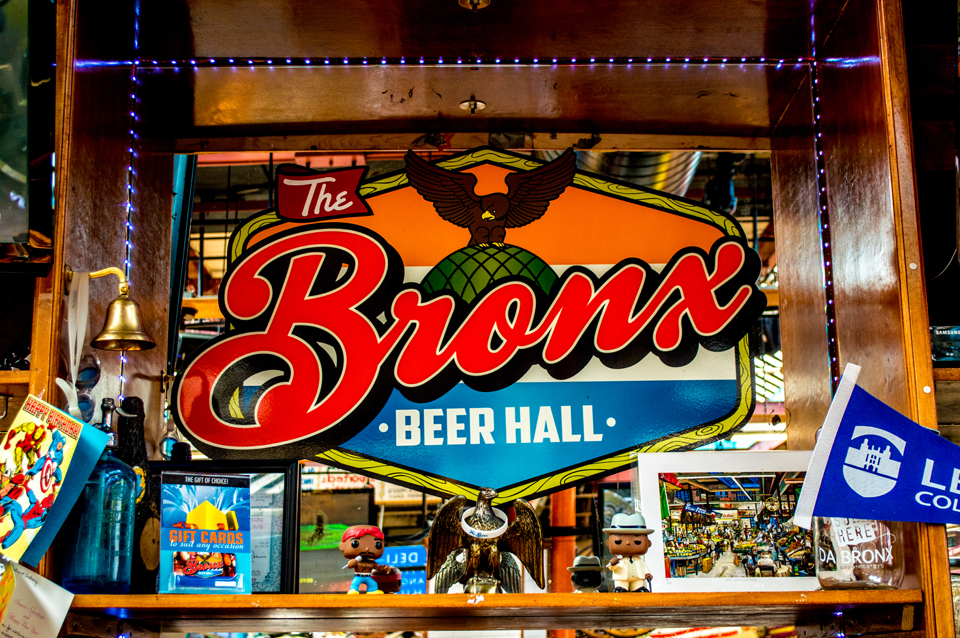
The Bronx Beer Hall (photo: Brian Nobili)
The following entry is part of The Small Business Corner, a collaboration between Gotham Gazette and GoBizNYC:
Recently, GoBizNYC met with Bronxites Anthony Ramirez II, Paul Ramirez, and John Martin to discuss their experience starting up The Bronx Beer Hall. Located in the historic Arthur Avenue Retail Market, The Bronx Beer Hall was founded in February 2013 and has since become an indelible part of the community. Anthony and John are serial entrepreneurs — in 2006, they founded Mainland Media, a company that sells Bronx-themed merchandise designed by local artists.
The team's ongoing mission is to find success while promoting the Bronx and it has earned tremendous local support. In the early stages of starting their business, however, the three had a tough time identifying information about what was required of New York small business owners to satisfy government regulations. To its credit, the City does provide resources about business regulations through the NYC Business internet portal as well as the NYC Business Solutions and NYC Business Acceleration services. New Small Business Services Commissioner Maria Torres-Springer has outlined her vision for helping small business owners and budding entrepreneurs.
The Bronx Beer Hall founders discovered, though, that every business faces unique challenges and becoming a fully compliant owner and employer can be a process of trial and error. Their experience is informative of what many small business owners go through in attempting to realize their goals. The following are excerpts from our conversation.
Why a beer hall? Why the Bronx?
Beer halls are inherently communal spaces. There are about 130 beer halls across the five boroughs now, but just one in the Bronx when we opened. But this is not just a beer hall. It's not just a bar. It's a celebration of the community. Everything we sell is locally brewed within New York State, if not in the Bronx. And our food is sourced from within the market or within the neighborhood, so we're supportive of other local businesses as well.
What were the biggest challenges of starting up your business? How did you overcome these challenges?
It's not as easy as saying you're a business and that's it. It's not just shaking hands. You have to do your research. There are government regulations to comply with. There are taxes to pay. There is paperwork to file and legal entities to form.
When it came down to the beer hall itself, we had to learn all the little intricate things you never think about. We've all gone to bars. I know how to order a drink very well. But I didn't know anything about health codes, inspections, or liquor licenses. None of us had actually owned a bar before. I know for a fact that if we opened a bar again, we'd do things differently.
Did you have any guidance during this process?
We hired a lawyer who claimed he had experience in helping restaurants and bars open and had been doing this forever. Turns out we should've hired a different lawyer. He was very quick to make promises, saying: "I can get you this, easy!" or "Yeah, I'll get you a liquor license in two weeks!" No one can get a liquor license in two weeks. It's going to take several months. Don't tell me two weeks. If I plan on opening a bar in November, I now have to wait until February. You're paying for these kinds of things and there's just no way of knowing if you're working with someone who really knows what they're doing.
We've since learned that there are many things we could've easily done on our own without having to pay somebody else to do it. Lots of people try to take advantage of you because you don't know what you're doing. But in this day and age, often you can just go online and file a form. You don't need to pay somebody $400 to do it. We just didn't know it at the time.
What has been your experience in dealing with government regulations? What could the government do to better support businesses like yours?
At the beginning, we had no idea we had to pay our taxes quarterly, which was a problem. Reminder notifications definitely would've been nice. The only notifications we ever got were late ones saying: 'You didn't pay your sales tax. Now we're going to fine you and you have to pay your sales tax.' And we're like, 'Our company only has $1,000. I hope we still have a company after we pay the fine.' But the thing is, we were collecting the sales tax. We just didn't know when to pay it.
And it wasn't clear what we were required to do when we had staff. Now we know more, but at the time, we were writing out checks by hand. I remember, for the first two or three weeks, we weren't taking out enough taxes. Our staff was getting overpaid and we owed the government X amount of money.
Those were the early days. Those sorts of things were trial and error for us. But we got better at all of it. I know it's easy to say and hard to do, but if there was a "You're starting a restaurant or bar in New York City! This is what you need to be aware of" guide, that would've been very helpful.
Have you worked with the City's Department of Small Business Services (SBS) at all? They provide such a guide along with other resources.
When we were starting Mainland Media, we reached out to SBS, but it was too difficult for us to meet with them. So we ended up doing everything on our own, which is what we're used to doing. Honestly, I didn't even think to go back to SBS when we were starting up the beer hall more recently. It didn't even occur to us that those services were around.
Any final reflections on your experience of starting up The Bronx Beer Hall?
We've been active in the Bronx and in the community for awhile, so we had a lot of people we could reach out to for help. But if we didn't already have a strong support system and experience building a business with Mainland Media, we would've been lost. So, if you're someone with a great idea in the Bronx or New York without that kind of support system, I don't see how you would be able to cut it.
***
Victor Wong is the Director of Business Outreach & GoBizNYC at the Partnership for New York City
To make or discuss a submission for The Small Business Corner:
Reach GoBizNYC Director Victor Wong at This email address is being protected from spambots. You need JavaScript enabled to view it.
Reach Gotham Gazette Executive Editor Ben Max at This email address is being protected from spambots. You need JavaScript enabled to view it.
The Small Business Corner is a bi-weekly column featuring the opinions and perspectives of small business owners and advocates from the GoBizNYC network on the range of issues that concern the city's small businesses.
To all New York City small business owners and advocates: we hope this new platform, The Small Business Corner, will better enable you to engage in the local policy conversation and we look to you to support us in this endeavor by sharing your thoughts, experiences, and voices. To learn more about how you can be a part of GoBizNYC and participate in this effort, visit GoBizNYC.org.
March Shows Changing Climate for City Protest
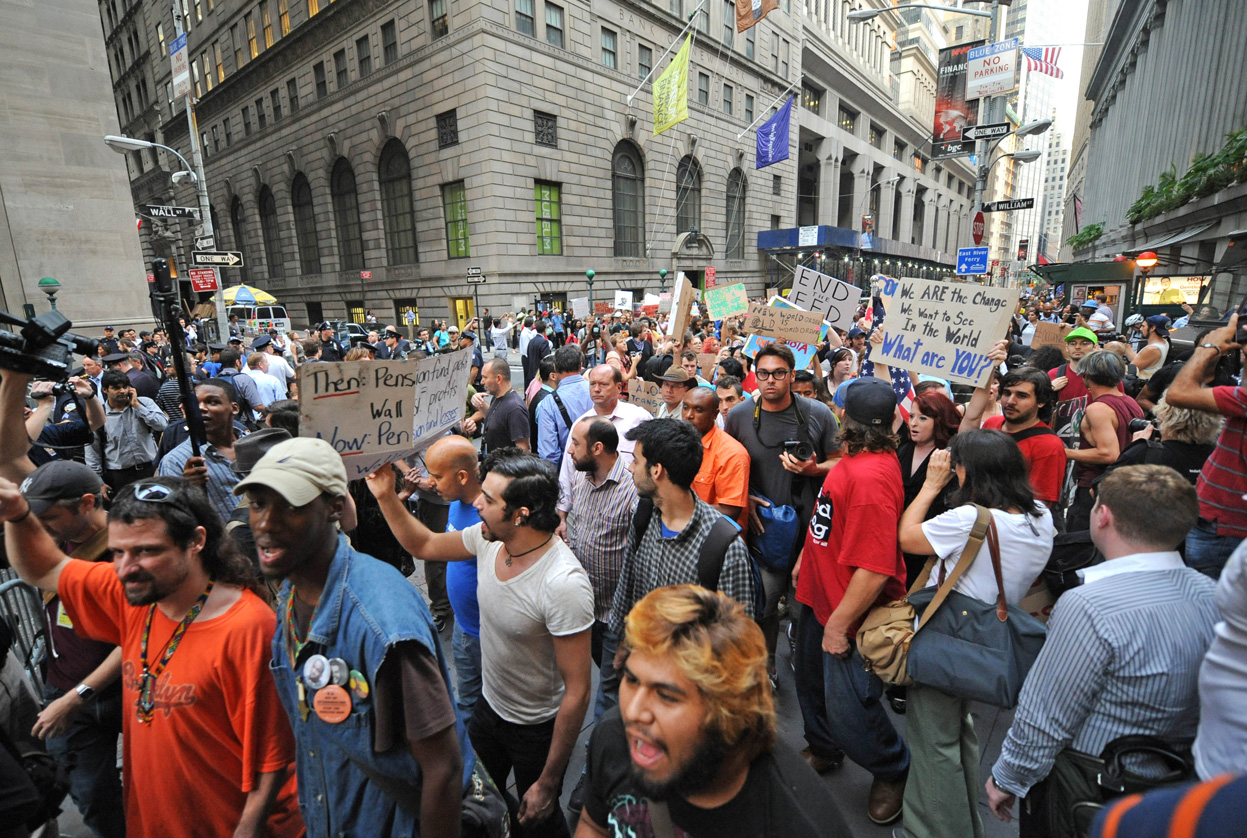
Protestors during Occupy Wall Street (photo: AP Photo/Louis Lanzano)
As illustrated by its slick subway ad campaign, and the participation of leading political figures including U.N. Secretary General Ban Ki-moon, this Sunday's People's Climate March intends to make a dramatic statement.
Led by the environmental activist group 350.org, the event's organizers promise the "largest climate change march in history." With numerous labor and community organizations on-board, it's likely that the protest will reach its goal of bringing 150-200,000 people to NYC streets.
But the mostly low-profile route of the march suggests that the right to protest on the streets of NYC remains under assault.
Departing from Columbus Circle, participants will head down 6th Avenue to 42nd Street, then move along 42nd to 11th Avenue, where they will hold various activities. The route straddles, but does not proceed through, Times Square.
Flash-back for a moment to the June 1982 anti-nuclear protest, when nearly one million people descended on the Great Lawn. Over the last decade, the city has tried to insulate many of its most symbolic spaces from demonstrations, with the Bloomberg administration denying access to both the U.N. and Great Lawn for Iraq War protests in 2003-4.
Sunday's event coincides with the U.N. climate summit that opens next Tuesday. With security procedures taking effect this weekend, a march ending at Dag Hammarskjold Plaza was not an option. Organizers thus aimed for the route to proceed through Times Square, enabling the protest to call attention to a global problem at "The Crossroads of the World."
Leslie Cagan, a main organizer of the Iraq War marches, led the negotiations for the People's Climate March. As she explains, the NYPD's representatives, made up primarily of commanders from Manhattan South, stated from the outset that Times Square was not an option—a position Cagan sums up as "just because."
Meanwhile, NYPD officials seemed in no hurry to finalize the route. According to Cagan, the "slow-moving" process took over four months after the first meeting in April.
Throughout the negotiations, leaders from various unions and community organizations participating in the march reached out to City Hall. Cagan says that the resulting meetings with de Blasio administration higher-ups showed that there was an "easier, friendlier" attitude towards street protest prevailing in the post-Bloomberg era.
Even so, the march route seems to lack symbolic value.
"We got most of what we wanted," says Paul Getsos, National Coordinator for 350.org. He stresses that the stretch along 42nd Street will enable participants to make their case at the entrance to Times Square.
Getsos also envisions that the stretch of 11th Avenue (from 42nd down to 34th) where the march ends will become a "celebratory, community-oriented" space, full of meet-up tables, artwork and various musical performances. According to Cagan, the NYPD raised no objection to organizers' requests for this area.
What's being billed as a history-making event thus ends at a nebulous location. And it's highly doubtful that by nightfall, the NYPD will allow the Javits Center and surrounding area to become anything resembling Zuccotti Park.
In part because they see the march as destined to be ineffectual, a variety of climate activists are planning "to flood Wall Street" on Monday. By denying access to places like Times Square for peaceful protest, city officials are thus spurring more disruptive direct action confrontations.
The current mayor may be more sympathetic to demonstrations, but the real problem is that his office doesn't control access to public space. While the NYPD decides what happens on city streets, the parks department has placed numerous restrictions on events at the Great Lawn.
One solution is for the mayor or public advocate to directly oversee the protest permit process, rather than let city agencies run the show. After all, if their voice is muted on the city's streets, the masses can at least hold elected officials accountable in the voting booth.
***
Theodore Hamm is chair of journalism and new media studies at St. Joseph's College in Clinton Hill, Brooklyn.
Do you have an op-ed idea or submission for Gotham Gazette? Send it to Executive Editor Ben Max: This email address is being protected from spambots. You need JavaScript enabled to view it.
Solving Our Voter Turnout Crisis
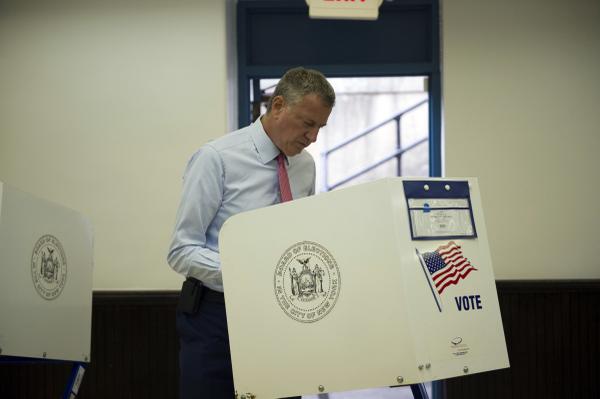
Mayor de Blasio casting his vote on primary day (photo: @BilldeBlasio)
Last week's Democratic gubernatorial primary saw shockingly low turnout among New York voters - less than 10% of the state's 5.8 million registered Democrats cast a ballot.
Except no one is shocked.
The latest sign of distress in our democracy didn't turn many heads because it was expected; another plot point on a downward sloping trend line, both here in New York and nationally. Our voter turnout crisis is very real and should be troubling to anyone who cares about democracy, responsible government, and good public policy.
A primary day tweet from the account of Mayor Bill de Blasio reads, "Do your civic duty, New York City-vote today," above a picture of the mayor at his polling place. Reminders like this from the mayor and many other civic leaders have no effect, of course, as people have virtually all made up their minds about voting before the day arrives - especially on a day like last Tuesday with state-level primary elections in a non-presidential year. Sadly, an increasing number of potential voters are opting not to perform their "duty."
But who cares? We do not question the legitimacy of our governments, even if they are elected by a smaller and smaller percentage of constituents. Non-voters are adults, people who understand at least the general concepts of democracy, voting, and government. To boot, when we talk about voter turnout, we typically use stats based on registered, not eligible voters (estimates are that in the U.S. a little over 70% of eligible voters are registered).
Those who decide not to participate, for whatever reasons, are ceding power to those who care, those who organize and fight for their interests. Non-voters give tacit approval of whatever outcomes result; providing their proxy to the voters who opt in.
I, for one, don't want an increasingly diminishing portion of the potential electorate to decide the outcomes of our elections and therefore, much of our public policy. But, I also don't want even more uninformed voters heading to the ballot box to simply fill in an oval next to the name they recognize most from TV ads or mailers.
I want a flourishing democracy.
There are all sorts of election-related reforms that can and probably should be enacted, of course, and if you're reading this article you might very well already be able to list them: same-day registration; open primaries; term limits; and greater campaign finance regulations, among others. But, there's another essential element: education.
We've become scared of politicizing the classroom. By and large, we don't teach current events - which we should be doing in every subject area, not just social studies, where it happens at times. For the most part, we aren't infusing real-world issues and experiences into coursework, even in college.
We aren't exposing our children to civic thinking from a young age.
Just like we should (but don't) immerse our students in the study of foreign language from a young age, we should immerse them in the study of public life. We should invite our students to think critically about the world around them, we should invite debate. We should provide opportunity for authentic experiences and community service learning and action civics. We should allow young people to help make public policy.
We need a generational shift. It won't happen overnight, but it can happen.
This shift will take a reimagining of our schools, of our classrooms and our curriculums. It will take a retraining of our teachers and our after-school program providers. But, like with just about everything we should scale up, we have enough people doing things the way I'm describing that we can get there in due time. Positive shifts in focus from teacher-centered to student-centered classrooms and the increased honus on critical thinking skills are part of the equation.
As New York State and municipalities therein adapt to the common core standards and revamp both curriculum and instruction toward meeting them, there is a perfect opportunity to make more changes. The best outcome won't even be increased voter participation, it will be that virtually everyone involved enjoys school more and gets more out of it because it is a place of relevant, real-world thinking and action.
Voters and non-voters alike have little faith in elected officials to be honest and effective, but are generally not thoughtful about solving this problem. Instead, people disengage - or stay disengaged or withdraw further. To change that and ensure a social norm of critical thinking about public life and policy, we must establish this m.o., making it a part of who we are and what we do: in the classroom, at the dinner table, everywhere.
Many of the adults who care about politics and government were the kids who cared about politics and government. These people are the exception. To make them - us - the rule, we must encourage engagement from a young age.
Even in today's school culture, when you ask young people about problems with the world around them and for ways to do things differently, the floodgates open.
Yet, we don't often ask those questions and therefore, when the gates to the polling place are flung wide, there is not a flood of voters, but a trickle.
***
by Ben Max, executive editor, Gotham Gazette
@TweetBenMax
Small Business Cost & Regulatory Hurdles in New York City
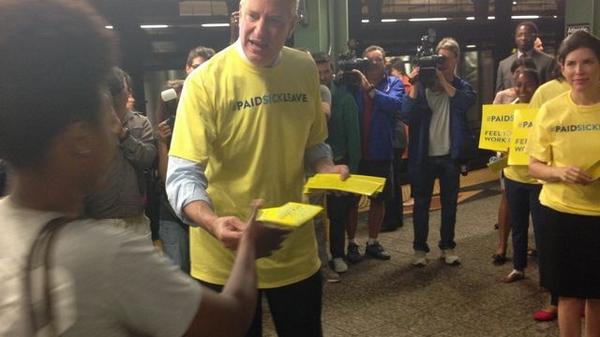
Mayor de Blasio promotes paid sick leave (photo: @NYCDCA)
The following entry is part of The Small Business Corner, a collaboration between Gotham Gazette and GoBizNYC:
We seldom hear small business owners weigh in on the public policy issues that impact their ability to hire and grow in New York City, partly because they are busy earning a living and partly out of their fear of getting embroiled in politics that could impact their customer and regulatory relationships. The following is a telling interview with Rachel, an entrepreneur who asked us not to use her last name, but whose story reflects the experience of neighborhood businesses throughout the five boroughs.
Why did you decide to start a business in NYC?
I grew up in NYC and have chosen to raise my family here. This is the best city in the world and, after over a decade as a retail executive in Corporate America, I decided to open up a retail children's store in the neighborhood where I grew up. Children's retail is a great business and there is nothing better than making a child smile.
What have been unexpected challenges you've faced?
I have been surprised by the number of hurdles you face when trying to open a business in NYC. For example, I hunted for weeks to find an "affordable" space. I found a great location for about $16,500 per month, but with all my fixed costs, I need to do over $700,000 in sales annually just to break even. That is simply a bucketload of merchandise that I need to sell each year and makes me charge prices that are higher than I would like.
Then you get to taxes and realize the situation is even worse. When deciding how to structure my business, I was leaning toward registering as an S Corp, since this typically provides tax and legal advantages compared to registering as a Limited Liability Corporation (LLC). But then I found out that NYC does not recognize S Corps, subjecting them to an 8.85% General Corporation Tax. So I said, 'Okay, I will become an LLC instead.' I then discovered that LLCs are subject to a 4% Unincorporated Business Tax (UBT) in NYC, with Medicare and Social Security taxes on top of that. So you get hit hard no matter which structure you choose. There is a tax credit available for small businesses that pay the UBT, but only those that do under $150,000. If I do that volume, I would need to shut my doors.
Lastly, there are many local mandates that have been passed that are going to burden small businesses even more and hurt employees at the same time. Quite frankly, if I didn't love NYC and wasn't raising a family here, I definitely would not be opening up here. I could go across the river to Hoboken and launch the exact same concept with a fraction of the costs and hassles.
Can you give an example of the impact of City regulations on small business?
The NYC Paid Sick Leave Law is something I have been learning about and trying to navigate. This law has great intentions – to make sure that each employee gets paid sick leave, if needed. I believe that this is the right thing to do and that employees should not be penalized if they are legitimately sick. But this law is unduly onerous to small employers. Given the fact that an employer has to pay for staff coverage while also paying for an employee who is out sick, even if you have just 5 full-time employees, your costs still increase by thousands of dollars each year.
This law also has unintended negative consequences on employees. I have found that employers are now very reluctant to give any one employee more than 15-25 hours per week. They would rather have more part-time employees and delay their accrual of paid sick days – it just makes financial sense. Even worse, some businesses are misinterpreting the law, thinking that employees only earn the accrual if they work 30 hours per week, rather than 30 hours at any point, so they are cutting back their employees' hours. As a result, employees work fewer hours and accrue paid sick days more slowly. This is a well-meaning but not well-thought-out law that ends up hurting the very people it aims to help.
How does this law affect your hiring decisions?
I have to think seriously about who I am hiring and whether they might need more sick leave than someone else. I am a very sympathetic person and would give my employees whatever they legitimately need to take care of personal or family illness. But I am nervous someone will take advantage of me. Since this law does not require a doctor's note unless someone is out for 3 days in a row, you can envision that even the most well-meaning employees might take advantage of a full paid day off. Sure, most employees are honest and hopefully will not do this. But how can the employer know?
What could the City do to better support businesses as they strive to appropriately comply with the new law?
The City needs to rethink paid sick leave for smaller companies. I suggest exempting small businesses with fewer than 20 employees, changing the rate of accrual to one hour per 40-50 hours worked, and starting accrual after the first 90 days of employment. The City also needs to continue educating employers, especially those who are misinterpreting the law.
I love NYC and I want my business to succeed and grow here. I have been impressed by many of the free resources the City has made available to small business owners online. That said, I wish the City would do more to help me financially. Given the high costs of doing business here as well as the costs of complying with local regulations, many small business owners are struggling to make ends meet, just like the employees who work for them. What will the City do to help us? Sometimes, it seems like the City wants us to go elsewhere.
***
Victor Wong is the Director of Business Outreach & GoBizNYC at the Partnership for New York City
To make or discuss a submission for The Small Business Corner:
Reach GoBizNYC Director Victor Wong at This email address is being protected from spambots. You need JavaScript enabled to view it.
Reach Gotham Gazette Executive Editor Ben Max at This email address is being protected from spambots. You need JavaScript enabled to view it.
The Small Business Corner is a bi-weekly column featuring the opinions and perspectives of small business owners and advocates from the GoBizNYC network on the range of issues that concern the city's small businesses.
To all New York City small business owners and advocates: we hope this new platform, The Small Business Corner, will better enable you to engage in the local policy conversation and we look to you to support us in this endeavor by sharing your thoughts, experiences, and voices. To learn more about how you can be a part of GoBizNYC and participate in this effort, visit GoBizNYC.org.
Climate Change and Disaster Recovery: The Soul of Our Work Together
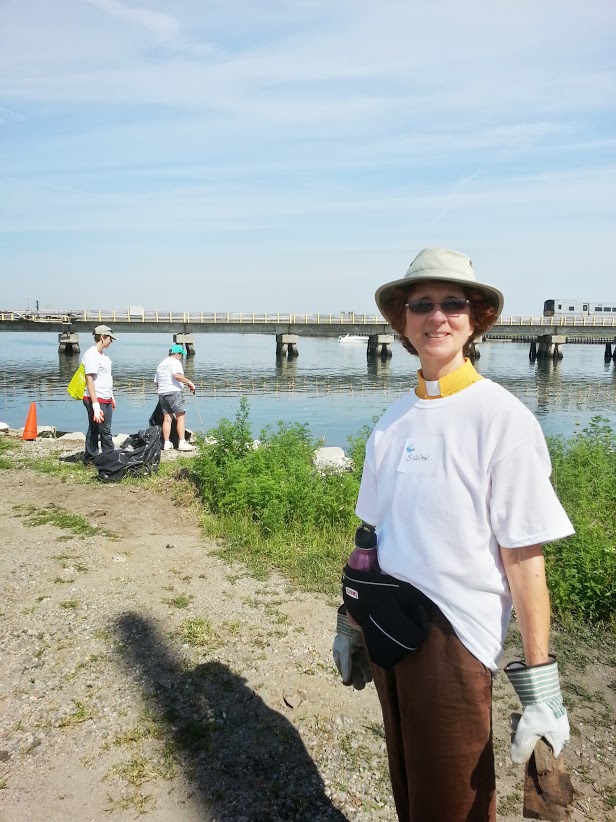
The author participating in clean-up efforts
On the evening of October 29th, 2012 Superstorm Sandy struck the New York Metro area with unbridled ferocity and though city planners were aware of the risks, the infrastructure was not at all prepared to deal with the immediate effects or the aftermath of such a massive natural disaster.
Superstorm Sandy proved to be the intersection of climate change and a compassionate response to disasters in a way that I could never have envisioned before. I had been stewing over our society's lackadaisical response to climate change, and what the potential consequences could be. But in my role as Disaster Response Coordinator for the Unitarian Universalist Association (a grant-funded role specifically created for post-Sandy needs), I began to really see how all the social justice work I am called to do matters little if we continue to ignore what we are doing to the earth.
At the moment, faith groups are preparing to join thousands of others who will be coming to New York City at the same time as a UN Climate Summit at which world leaders will be discussing a global deal on climate change. While all these discussions continue at a global scale, it is crucial that we show that communities are coming together to say that we are committed to climate action. That being said, our responsibilities do not begin or end on this day. Metro New York's capacity to respond to climate change was, of course, tested long before we began organizing for this march.
After Superstorm Sandy, a number of community organizations demonstrated that low-income renters—mostly people of color and immigrants—were disproportionately impacted by the wrath of Sandy. But they had another strike against them: recovery assistance available to them was paltry in comparison to that of Sandy-pummeled homeowners. Obviously this was not a first time occurrence. Renters on the Gulf Coast were also hit hard by Katrina and assistance to renters there also was minimal (see "Treading Water: Renters in Post Sandy New York City" by Make the Road New York).
I am still working with congregations of volunteers coming to Metro New York to assist with Sandy relief, particularly for the most marginalized homeowners. But the issue that keeps me up at night is the slow and dispassionate response to the needs of low-income renters, many of whom are fearful to sign up for the few benefits available to them. Many undocumented renters are fearful that they might be deported or be profiled. Some immigrants do not understand the materials written in English and translation services are unavailable in many cases. Renters also have to go into Manhattan to apply for some forms of assistance while homeowners often can simply go to nearby local offices.
Two years is too long to respond to any massive disaster. Storms such as Sandy or Katrina, both of which we are still recovering from, will keep testing us. We need to respond with compassion and care to find homes, housing, food, and other services for people. Above all, we need to plan and understand our holistic relationship to this earth, to the skies, and to the seas that surround us. We need to look at climate change head on, not avert our eyes any longer because the pain and sorrow will not go away.
Like Katrina, Sandy was amplified by the changing climate: warmer oceans, jet stream weakening, and a wetter atmosphere. Climate Change is here. And we, the people of this planet, with brains and hearts to creatively deal with this climate crisis turn the other way.
Every faith asks that we respond in solidarity with those with the greatest needs. Our prayers, our actions, our community gatherings all must be centered in responding to climate change. There is plenty we can do. Most certainly, turning away will not ameliorate the climate crisis brewing in our universe.
Sweet Honey in the Rock, a beautiful acapella African-American singing group, put Gandhi's words rousingly to music: "We are the ones we've been waiting for." Indeed, we are. Let us join one million strong in New York City for the People's Climate March on September 21. Let us share this earth and join in solidarity to show the leaders of the UN Summit that we will not turn away. We are one and we are marching with one voice.
***
The Rev. Susan Karlson is a Unitarian Universalist community minister currently working on Superstorm Sandy Recovery throughout the Metro NY area. She is also the co-chair of the New Sanctuary Coalition of New York City, an interfaith organization that supports, empowers and witnesses with immigrants, and she is a 2015 Green Faith Fellow.
